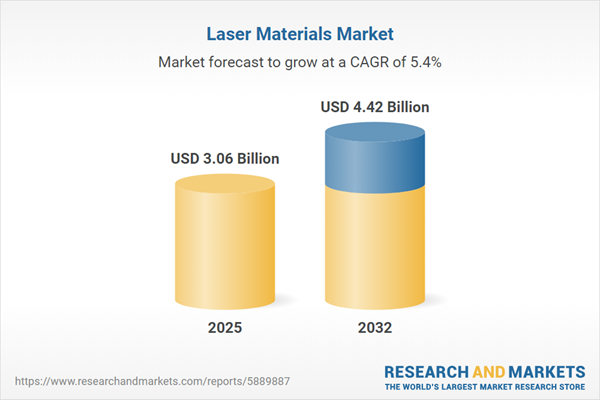Speak directly to the analyst to clarify any post sales queries you may have.
The laser materials market is experiencing accelerated transformation as organizations adapt to shifting technology frontiers, evolving industrial needs, and dynamic supply chain considerations. Senior executives must leverage forward-looking insights to manage complexity and capture value in this rapidly changing sector.
Market Snapshot: Laser Materials Market Performance and Outlook
The laser materials market is advancing consistently year over year, guided by enduring demand across healthcare, industrial automation, and research. Persistent investment is fostering the growth of advanced fiber, gas, and solid-state laser technologies that enhance industry-wide capabilities. Companies are proactively refining their product offerings and streamlining internal workflows to address customer requirements that continue to evolve in sophistication. The global landscape highlights the growing importance of adaptability and innovation, while maintaining strict regulatory compliance standards in diverse regional markets within the laser materials sector.
Scope & Segmentation: Strategic Insight for Executive Leadership
This report provides senior leadership with robust intelligence, focused on procurement, investment priorities, and overarching business strategy within the laser materials market. Covering present and future drivers, evolving technologies, sector-specific priorities, and global compliance trends, the analysis supports informed direction for both commercial and technical decisions. Key segmentation is as follows:
- Laser Types: Overview of primary categories such as fiber lasers (erbium-doped, thulium-doped, ytterbium-doped), gas lasers (argon ion, CO2, excimer, helium-neon), and solid-state lasers (alexandrite, Nd:YAG, Nd:YVO4, ruby, Yb:YAG), with attention to their roles in manufacturing, healthcare, and research.
- Applications: Coverage of diverse uses including medical diagnostics, surgical procedures, industrial manufacturing (cutting, welding, engraving, marking), and photonics R&D.
- Material Types: Assessment of crystals, glasses, and polymers such as polycarbonate and polystyrene, evaluated for performance, sustainability, and adaptability across industrial and medical environments.
- Form Factors: Analysis of bulk, fiber-cut, spooled, and powder laser formats in optimizing production and laboratory workflows.
- End Users: Identifies core sectors—automotive, defense, electronics manufacturing, and healthcare—emphasizing technical needs, production scale challenges, and regulatory considerations.
- Regions: Regional assessment across the Americas, Europe, the Middle East, Africa, and Asia-Pacific, including targeted analysis for China, India, Japan, Australia, South Korea, and Southeast Asia as critical growth zones.
- Key Companies Tracked: Company profiles include IPG Photonics Corporation, TRUMPF GmbH + Co. KG, II-VI Incorporated, Lumentum Holdings Inc., Hamamatsu Photonics K.K., Jenoptik AG, nLIGHT Inc., Lumibird S.A., Gooch & Housego PLC, and MKS Instruments, Inc., reflecting global influence and expertise in innovation.
Key Takeaways for Senior Decision-Makers
- Developments in laser material science are expanding both technical and operational capabilities, opening new horizons for deployment in regulated and specialist settings.
- Industry innovation emphasizes compact device design and energy efficiency, which supports sustainable operations and broader use across multiple industries.
- Strategic agreements—including licensing and R&D collaboration—facilitate access to novel materials and underpin agile supply chain practices.
- Robust procurement and risk management infrastructures are essential for counteracting supplier inconsistency and maintaining reliable market presence.
- Consistent quality in laser materials enhances trust, strengthening critical relationships with stakeholders and supporting enduring growth objectives.
Tariff Impact on Market Dynamics
Recent U.S. tariff policies have altered sourcing and production approaches within the laser materials sector. To manage evolving trade conditions, organizations are bolstering ties with established suppliers, prioritizing domestic manufacturing, and broadening reclamation and recycling efforts. These proactive strategies help maintain procurement stability and reinforce organizational resilience.
Methodology & Data Sources
This report integrates rigorous secondary research supported by interviews with executive and technical experts from the laser materials industry. Scenario-based modeling and thorough data validation ensure findings are actionable and relevant to strategic leadership needs.
Why This Laser Materials Market Report Matters
- Empowers executive teams to optimize investments, procurement planning, and risk controls in a technology-driven competitive environment.
- Enables benchmarking against leading industry players, identification of collaboration prospects, and monitoring of vital technology and regional trends.
- Equips leaders to build resilient supply networks and address regulatory, technology, and market developments with agility.
Conclusion
Senior decision-makers gain strategic direction, authoritative market benchmarks, and critical business intelligence with this report, enabling optimized sourcing, sustained competitiveness, and readiness for future laser materials market opportunities.
Additional Product Information:
- Purchase of this report includes 1 year online access with quarterly updates.
- This report can be updated on request. Please contact our Customer Experience team using the Ask a Question widget on our website.
Table of Contents
3. Executive Summary
4. Market Overview
7. Cumulative Impact of Artificial Intelligence 2025
Companies Mentioned
The companies profiled in this Laser Materials market report include:- IPG Photonics Corporation
- TRUMPF GmbH + Co. KG
- II-VI Incorporated
- Lumentum Holdings Inc.
- Hamamatsu Photonics K.K.
- Jenoptik AG
- nLIGHT, Inc.
- Lumibird S.A.
- Gooch & Housego PLC
- MKS Instruments, Inc.
Table Information
| Report Attribute | Details |
|---|---|
| No. of Pages | 192 |
| Published | October 2025 |
| Forecast Period | 2025 - 2032 |
| Estimated Market Value ( USD | $ 3.06 Billion |
| Forecasted Market Value ( USD | $ 4.42 Billion |
| Compound Annual Growth Rate | 5.3% |
| Regions Covered | Global |
| No. of Companies Mentioned | 11 |









